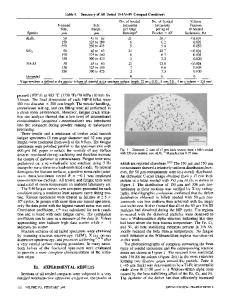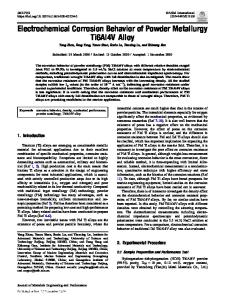Effect of isothermal forging on microstructure and fatigue behavior of blended elemental Ti-6Al-4V powder compacts
- PDF / 4,145,877 Bytes
- 11 Pages / 594 x 774 pts Page_size
- 54 Downloads / 263 Views
I.
INTRODUCTION
TITANIUM powder metallurgy has developed in recent years to the point that it can be a viable approach to production of high quality airframe and engine components. ~'2'3 Development of lower cost processes is one of the main goals of the titanium industry4 because of the basic high cost of the alloys and conventional titanium fabrication processes. The relatively inexpensive starting material (sponge fines) and simple process (cold press and sinter) make the blended elemental approach one of the least expensive titanium net shape methods. 5'6 It was also demonstrated recently that good quality plate products can be produced directly by this approach/However, unlike prealloyed titanium powder metallurgy, the blended elemental method does not produce 100 pct density compacts using current practices 5'6 even with post sintering hot isostatic pressing (HIP) 8 or forging. 9 This is the result of chloride contamination inherited in the titanium sponge fines produced either by the Hunter Process (HP) (sodium reduction)l~ or the Kroll Process (magnesium reduction). I1 The density of cold pressed and sintered alloys is typically from 95 pct to 98 pct. 8 This density can be improved in low chloride compacts to as high as 99.8 pct by post sinter HIP'ing. ~2 The nature of the unhealed pores as well as the associated contamination have been characterized in detail by Welsch et al. 13'14 The residual porosity was found to cause degradation of initiation related properties, such as high cycle fatigue, when compared to ingot metallurgy and fully dense prealloyed powder metallurgy products, t'8'9'15 The objective of the present work was to improve high cycle fatigue properties of Ti-6A1-4V blended_ elemental 1. WEISS is Associate Professor, School of Engineering, Wright State University, Dayton, OH 45435. D. EYLON is Professor, Graduate Materials Engineering, University of Dayton, Dayton, OH 45469. M. W. TOAZ is Group Leader, Imperial Clevite, Inc., Technology Center, 540 East 105th Street, Cleveland, OH 44108. F.H. FROES is with Air Force Wright Aeronautical Laboratories, Materials Laboratory, AFWAL/MLLS, WrightPatterson AFB, OH 45433. Manuscript submitted lanuary 17, 1985. METALLURGICALTRANSACTIONS A
sintered compacts by increasing the density and modifying the microstructure using isothermal hot forging (IHF) and lower chloride sponge fines produced by the electrolytic reduction process (EP). IHF was expected to further densify the compacts beyond the as-sintered level and to produce a lower aspect ratio recrystallized microstructure which is known to be more crack initiation resistant. ~6't7 Hunter Process (HP) J~fines, the most commonly used material in previous studies of blended elemental titanium powders, 5'6'8"13were used in this work as a baseline.
II. MATERIALS AND EXPERIMENTAL PROCEDURES
A proprietary process 5 was used to produce the Ti-6AI-4V elemental blends used in fabricating the preforms for this study. Two types of titanium powder were employed: minus 80 mesh sponge fines from the Hunter Pro
Data Loading...











